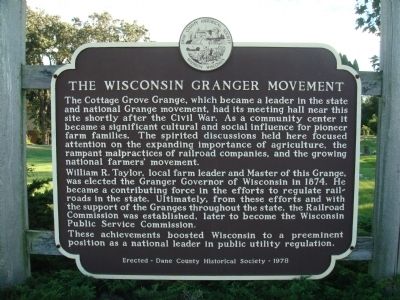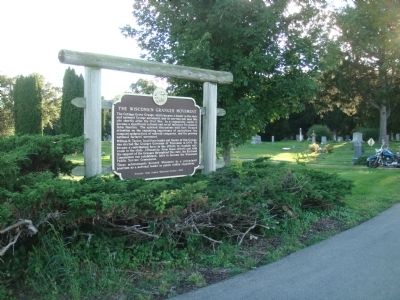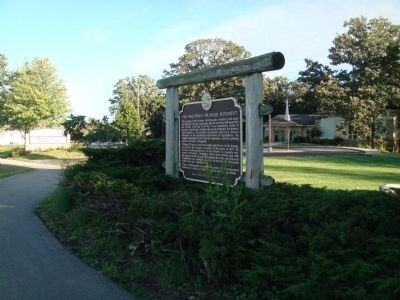Cottage Grove in Dane County, Wisconsin — The American Midwest (Great Lakes)
The Wisconsin Granger Movement
William R. Taylor, local farm leader and Master of this Grange, was elected the Granger Governor of Wisconsin in 1874. He became a contributing force in the efforts to regulate railroads in the state. Ultimately, from these efforts and with the support of the Granges throughout the state, the Railroad Commission was established, later to become the Wisconsin Public Service Commission.
These achievements boosted Wisconsin to a preeminent position as a national leader in public utility regulation.
Erected 1978 by the Dane County Historical Society. (Marker Number 17.)
Topics and series. This historical marker is listed in these topic lists: Agriculture • Government & Politics • Railroads & Streetcars. In addition, it is included in the Wisconsin, Dane County Historical Society series list. A significant historical year for this entry is 1874.
Location. 43° 5.202′ N, 89° 12.626′ W. Marker is in Cottage Grove, Wisconsin, in Dane County. Marker is on West Cottage Grove Road (County Highway Bb) half a mile west of Main Street (County Highway N), on the left when traveling west. Touch for map. Marker is in this post office area: Cottage Grove WI 53527, United States of America. Touch for directions.
Other nearby markers. At least 8 other markers are within 6 miles of this marker, measured as the crow flies. Alexander Smith House (approx. 4.1 miles away); Conical Mound (approx. 4.2 miles away); Drohman Farm (approx. 4.4 miles away); Boutell House (approx. 4.9 miles away); Hiestand School (approx. 4.9 miles away); Hiestand Park (approx. 5.1 miles away); The Monona Mound (approx. 5.8 miles away); Reindahl Memorial Park (approx. 5.9 miles away).
Regarding The Wisconsin Granger Movement. According to the Houghton Mifflin Reader's Companion to American History, the Granger Movement was a 19th-century political movement by farmers. It began on December 4, 1867, in Washington, D.C., with the formation of a secret fraternal society for farmers called the National Grange of the Patrons of Husbandry. During the next decade it spread rapidly, fed by agrarian desperation over hard times, high railroad shipping rates, and tight money, and by 1875, the membership had passed 850,000. Its central issue was the exploitation of farmers by railroads, merchants, and banks and its remedies for those ills included farmer-owned cooperatives and banks and state laws regulating railroads and grain elevators. Opposition from business interests and the Grangers' own political inexperience led few of their initiatives to succeed, but they set important precedents with their legislation, particularly those regulating railroads.
Credits. This page was last revised on June 16, 2016. It was originally submitted on October 26, 2010, by William J. Toman of Green Lake, Wisconsin. This page has been viewed 1,343 times since then and 58 times this year. Photos: 1, 2, 3. submitted on October 26, 2010, by William J. Toman of Green Lake, Wisconsin. • Bill Pfingsten was the editor who published this page.


